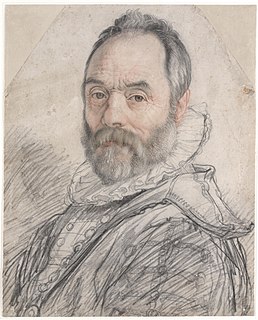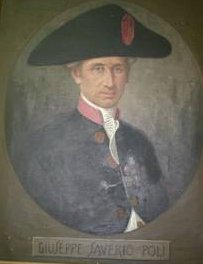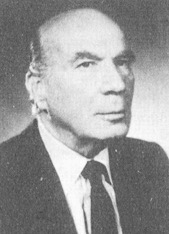
Paolo Uccello, born Paolo di Dono, was a Florentine painter and mathematician who was notable for his pioneering work on visual perspective in art. In his book Lives of the Most Excellent Painters, Sculptors, and Architects, Giorgio Vasari wrote that Uccello was obsessed by his interest in perspective and would stay up all night in his study trying to grasp the exact vanishing point. While his contemporaries used perspective to narrate different or succeeding stories, Uccello used perspective to create a feeling of depth in his paintings. His best known works are the three paintings representing the battle of San Romano, which were wrongly entitled the Battle of Sant'Egidio of 1416 for a long period of time.

Lucca is a city and comune in Tuscany, Central Italy, on the Serchio River, in a fertile plain near the Ligurian Sea. It is the capital of the Province of Lucca. It is famous for its intact Renaissance-era city walls.

Donato di Niccolò di Betto Bardi, better known as Donatello, was an Italian sculptor of the Renaissance. Born in Florence, he studied classical sculpture and used this to develop a complete Renaissance style in sculpture, whose periods in Rome, Padua and Siena introduced to other parts of Italy a long and productive career. Financed by Cosimo de' Medici, Donatello's David, was the first freestanding nude male sculpture since antiquity. He worked with stone, bronze, wood, clay, stucco and wax, and had several assistants, with four perhaps being a typical number. Though his best-known works were mostly statues in the round, he developed a new, very shallow, type of bas-relief for small works, and a good deal of his output was larger architectural reliefs.

Andrea Mantegna was an Italian painter, a student of Roman archeology, and son-in-law of Jacopo Bellini.

Giambologna — — was a Flemish sculptor based in Italy, celebrated for his marble and bronze statuary in a late Renaissance or Mannerist style.

Antonello da Messina, properly Antonello di Giovanni di Antonio, but also called Antonello degli Antoni and Anglicized as Anthony of Messina, was a Sicilian painter from Messina, active during the Early Italian Renaissance. His work shows strong influences from Early Netherlandish painting, although there is no documentary evidence that he ever travelled beyond Italy. Giorgio Vasari credited him with the introduction of oil painting into Italy. Unusually for a south Italian artist of the Renaissance, his work proved influential on painters in northern Italy, especially in Venice.

Pinerolo is a town and comune in the Metropolitan City of Turin, Piedmont, northwestern Italy, 10 kilometres (6.2 mi) southwest of Turin on the river Chisone. The Lemina torrent has its source at the boundary between Pinerolo and San Pietro Val di Lemina.

Antonio Corradini was an Italian Rococo sculptor from Venice. He is best known for his illusory veiled depictions of human body, where the contours of the face and bodies beneath the veil are discernible.

Bartolomé Pérez de la Dehesa was a Spanish painter of the Baroque period.

The Doccia porcelain manufactory, at Doccia, a frazione of Sesto Fiorentino near Florence, was in theory founded in 1735 by marchese Carlo Ginori near his villa, though it does not appear to have produced wares for sale until 1746. It has remained the most important Italian porcelain factory ever since.

Giuseppe Saverio Poli was an Italian physicist, biologist and natural historian.
Carlo Mazzone-Clementi was a performer and founder of two schools of commedia, mime and physical theater as well as a contemporary and colleague of leaders of modern European theater. From his arrival in the USA in 1957, he was largely responsible for the spreading of commedia dell'arte in North America.
Donato Bilancia was an Italian serial killer who murdered seventeen people – nine women and eight men – on the Italian Riviera in the period from October 1997 to April 1998.
Germán Cueto was a Mexican artist. He was part of the initial wave of artistic activity following the Mexican Revolution. However, his stay in Europe from 1927 to 1932 moved him into more European and more abstract work, especially sculpture. While he had a number of exhibitions in Mexico during his life including a retrospective at the Museo de Arte Moderno in 1965, he did not have the kind of success that many of his contemporaries did as he did not follow the then dominant themes or styles of Mexican muralism movement. His work was considered to be avant-garde and is considered to be the first Mexican abstract artist, creating masks and sculptures of wood, wire, plastic, sheet metal, ceramic, electrical wire and other materials, traditional and non-traditional.

Guido Carli was an Italian banker, economist and politician.

Michele Niccolai is a sculptor born in Livorno. He spent his youth in Cecina. He learned to sculpt and fire clay using his garndfather's furnace.
Francesca Sacchi Tommasi is an independent Italian art dealer.
Dino Formaggio was an Italian philosopher, art critic, and academic.

Giovanni Maria Mosca or Giovanni Padovano was an Italian sculptor and medallist, active between 1515 and 1573, initially in the Veneto and after 1529 in Poland, where his first name was rendered Jan.
Carlo Belli was an Italian art critic, theorist, and writer.













